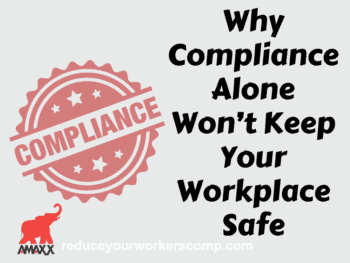
The reality is that OSHA compliance, when approached strategically, can be a powerful tool for business growth, cost reduction, and employee well-being. By shifting your perspective from compliance-as-burden to compliance-as-advantage, you can leverage OSHA requirements to create a safer, more productive workplace, reduce workers’ compensation costs, and enhance your company’s reputation.
Why the Traditional OSHA Mindset Falls Short
Most businesses treat OSHA compliance as a reactive, compliance-driven process. The cycle looks something like this:
- A safety issue is identified (often after an incident).
- OSHA requirements are reviewed to determine how to respond.
- A policy or training is implemented to check the compliance box.
- The issue fades into the background—until the next incident.
This approach is inherently inefficient. It forces businesses into a cycle of reacting to problems instead of proactively preventing them. More importantly, it misses out on the significant benefits that come with integrating OSHA standards into a broader workplace strategy.
Click Link to Access Free PDF Download
“4-Step Sequence For Effective Employee Screening, Hiring, & Placement”
Reframing Compliance as a Business Asset
Instead of viewing OSHA requirements as an administrative hassle, consider how they can be leveraged to improve efficiency, reduce costs, and drive business growth. Here’s how:
1. OSHA Compliance as a Cost-Saving Strategy
Workplace injuries are expensive. The direct costs of workers’ compensation claims, medical expenses, and lost productivity add up quickly. But the indirect costs—hiring replacements, training new employees, legal fees, and potential OSHA fines—can be even higher.
A proactive safety strategy aligned with OSHA standards can drastically reduce workplace injuries, lowering both direct and indirect costs. Data from OSHA and the National Safety Council consistently show that businesses that invest in safety programs experience lower insurance premiums, fewer lost workdays, and improved productivity.
Strategic Shift: Instead of viewing OSHA compliance as an expense, consider it an investment in reducing long-term operational costs.
2. OSHA Standards as a Blueprint for Operational Excellence
OSHA’s safety regulations aren’t just about avoiding fines—they’re based on industry best practices designed to create safer and more efficient workplaces. Companies that integrate these standards into their daily operations often experience:
- Increased employee morale and retention
- Lower absenteeism
- More efficient workflows due to safer, well-organized work environments
By embedding OSHA guidelines into your company culture, safety becomes a natural part of operations rather than a last-minute add-on.
Strategic Shift: Treat OSHA’s guidelines as a roadmap to operational efficiency rather than a list of compliance tasks.
3. Safety Culture as a Competitive Advantage
A strong safety culture can enhance your company’s reputation and position in the market. Clients and business partners increasingly look for vendors and contractors with strong safety records. A company with a low incident rate and high OSHA compliance can win contracts over competitors with poor safety histories.
Additionally, potential employees—especially in industries with higher workplace hazards—want to work for companies that prioritize safety. A proactive safety program can be a strong recruiting tool, reducing turnover and improving workforce stability.
Strategic Shift: View OSHA compliance not just as risk management but as a differentiator that sets your business apart.
Practical Steps to Shift Your OSHA Mindset
1. Integrate Safety into Your Business Goals
OSHA compliance shouldn’t be a separate function—it should be part of your overall business strategy. Set key performance indicators (KPIs) for safety alongside financial and productivity goals. For example, track Total Recordable Incident Rate (TRIR) and benchmark it against industry peers to measure progress.
2. Automate and Streamline Compliance Processes
One of the biggest complaints about OSHA compliance is the administrative burden. Modern technology makes it easier than ever to track safety incidents, training records, and compliance documentation. Investing in a safety management system can reduce paperwork while improving real-time data insights.
3. Train Leadership to Champion Safety
Shifting OSHA from a compliance burden to a business advantage starts at the top. Train supervisors and managers to view safety as part of performance excellence, not just a legal requirement. Their buy-in will help integrate OSHA principles into daily workflows.
4. Engage Employees in the Process
Your frontline employees are your best asset when it comes to workplace safety. Instead of top-down mandates, involve them in safety initiatives. Encourage reporting of hazards, reward proactive safety behavior, and make training sessions interactive rather than a checkbox exercise.
5. Leverage OSHA Data for Continuous Improvement
OSHA data isn’t just for reporting—it’s a valuable source of insight. Analyzing injury trends, near-miss reports, and incident rates can help identify weak spots in your operations. Use this data to refine processes and prevent future injuries.
Conclusion: Make OSHA Work for You
OSHA compliance doesn’t have to be a burden—it can be a powerful tool for growth, cost savings, and a stronger workforce. By shifting from a reactive mindset to a proactive, strategic approach, businesses can transform safety from a compliance requirement into a competitive advantage.
Instead of dreading OSHA audits and paperwork, embrace the standards as a roadmap to a safer, more efficient, and more profitable workplace. The companies that thrive in today’s economy are those that recognize safety and compliance as assets—not obstacles.
Start making OSHA work for you, and you’ll see the benefits not just in compliance reports, but in your bottom line, your workforce stability, and your long-term success.

Contact: mstack@reduceyourworkerscomp.com.
Workers’ Comp Roundup Blog: http://blog.reduceyourworkerscomp.com/
Injury Management Results (IMR) Software: https://imrsoftware.com/
©2025 Amaxx LLC. All rights reserved under International Copyright Law.
Do not use this information without independent verification. All state laws vary. You should consult with your insurance broker, attorney, or qualified professional.

















